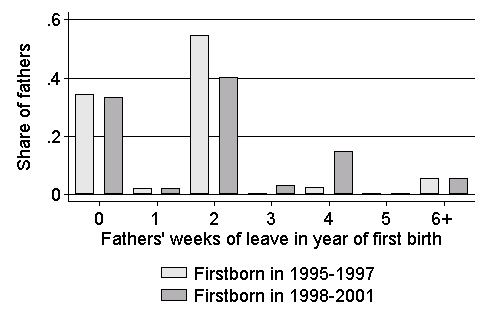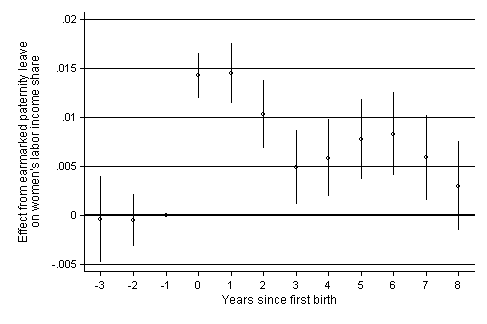Earmarked Paternity Leave and the Relative Income within Couples
Reducing gender inequality has become a central motivation for labor market and child-care policy reforms. Recently, for example, the European Parliament proposed to impose on member countries that each parent must have the right to two months of non-transferable paid parental leave. One of the main arguments for this EU-wide legislation is to lower gender inequality by reducing the flexibility of couples to allocate paid parental leave within the households.
Little is known, however, about the effects of earmarked parental leave for fathers on the relative income of women within couples. The intra-household income share of women likely reflects their bargaining power and shifting the income share within households thus has the potential to create permanent shifts in norms and gender inequality.
In new research (Druedahl, Ejrnæs and Jørgensen, forthcoming), we estimate the causal effect on the relative labor market income of women within the couple from increasing the earmarked paternity leave of fathers. We estimate the effect by utilizing Danish register data together with a reform to the parental leave rules in Denmark implemented in 1998. Concretely, fathers of children born before October 15, 1997 had 2 weeks of earmarked paternity leave (often used immediately after childbirth). Fathers of children born on or after October 15, 1997 had a total of 4 weeks of earmarked paternity leave.

A substantial share of first-time fathers did take 4 weeks leave despite the two additional weeks of earmarked leave had to be taken in weeks 25 and 26 after childbirth. Figure 1 illustrates the distribution of the number of weeks taken by first-time fathers who had their firstborn in the years 1995-1997 together with first-time fathers who had their firstborn in the years 1998-2001. We see a substantial shift from 2 to 4 weeks leave taken by first-time fathers.
We use this reform to estimate the impact on women’s labor income share within the household from this 2 weeks of increased earmarked paternity leave. We find a significant positive effect, suggesting that the labor income share of women increases with around 1.2 percentage points (from a baseline of around 42 percent prior to first childbirth). The increase in women’s labor income share arises because women's labor income increases significantly while the men's labor income is almost unaffected. Furthermore, the effect is relatively long lasting and remains significantly positive until the firstborn child is 8 years old, as illustrated in Figure 2.

We find that the effect is primarely driven by couples in which the woman was employed in the private sector prior to first childbirth. Interestingly, the fathers in this group increased their parental leave take-up by around twice as much as the fathers in the reference group of mothers working in the public sector prior to childbirth. This result is in line with the notion in Nielsen, Simonsen and Verner (2004) who find that there is no long run effect from taking parental leave for women employed in the public sector prior to childbirth.
References
Druedahl, J., Ejrnæs, M. and Jørgensen, T.H. (forthcoming): “Earmarked Paternity Leave and the Relative Income within Couples”, Economic Letters
Nielsen, H. S., M. Simonsen and M. Verner (2004): “Does the Gap in Family friendly Policies Drive the Family Gap?,” Scandinavian Journal of Economics, 106(4), 721–744.
You can read the working paper here
